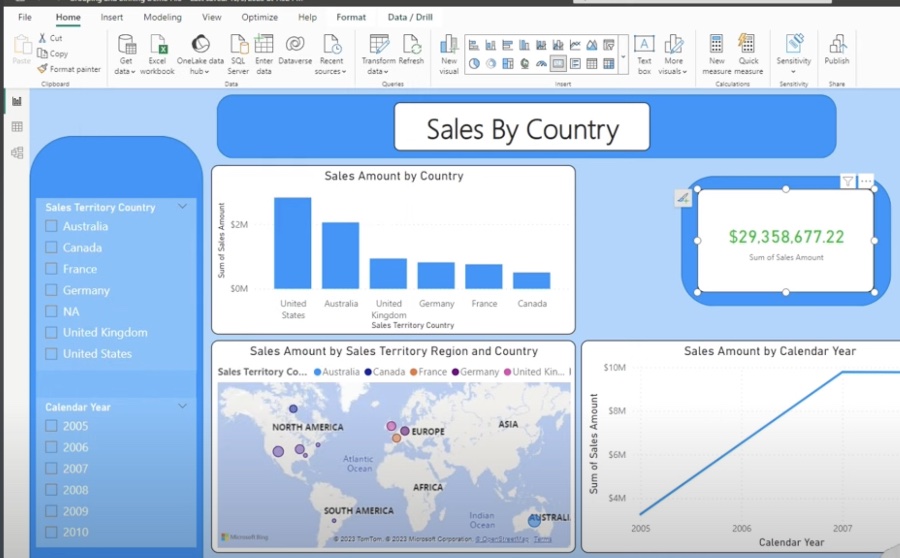Optimize Power BI: Color Contrast Guide
Maximize Accessibility in Power BI with Key Color Contrast Insights and Tools
Key insights
Understand the critical role of color contrast in Power BI reports to ensure they are accessible for all users, including those with visual impairments. The concept of Universal Design is emphasized, and the importance of thoughtful color choice is discussed to enhance report readability.
- Color contrast is pivotal for the accessibility and usability of data visualizations. It is vital to cater to users with visual impairments by selecting colors that provide adequate contrast.
- Meeting the Web Content Accessibility Guidelines (WCAG) 2.1 standards is necessary, with text requiring a contrast ratio of at least 4.5:1 and graphical elements a ratio of 3:1 or greater.
- Power BI's features, such as Accessible Themes, a color contrast checker, and an Accessibility Checker, assist in achieving the required color contrast in reports.
- For enhanced accessibility, use diverse indicators like labels or symbols rather than relying solely on color, select colors with complementary hues, and test your reports' grayscale visibility.
- It's recommended to use a limited color palette and involve individuals with color vision deficiencies (CVD) in your testing process to fine-tune the accessibility of your Power BI reports.
Power BI includes tools and guidelines to ensure accessible data visualizations, which is especially crucial for providing equal access to users affected by conditions like protanopia, deuteranomaly, and tritanopia. Adhering to WCAG standards, utilizing theme features, and checking color contrast cater to users' needs, creating more inclusive and readable reports.

Creating Accessible Visualizations in Power BI
In today’s data-driven environment, the creation of accessible visual content is paramount. Power BI offers a suite of options to help developers and analysts craft reports that align with Universal Design principles, ensuring that visualizations are interpretable by a wider audience. This commitment to accessibility not only supports those with impairments but also enhances the overall clarity of reports.
By incorporating high-contrast color schemes and adhering to established guidelines like WCAG 2.1, developers can make their reports more inclusive. Tools provided by Power BI, like color contrast checkers and accessibility checkers, simplify the process of verifying that visualizations meet the necessary standards.
Furthermore, employing practices such as avoiding over-reliance on color as the sole means of differentiation and involving users with CVD in the testing phase are part of a comprehensive approach to creating accessible content. Ultimately, these practices result in Power BI reports that not only look good but are also functionally accessible to as many users as possible, reflecting the core principles of Universal Design.
Enhancing Data Visualization Accessibility
Creating data visualizations that everyone can understand is crucial for effective communication in Power BI. Accessibility is not just about following guidelines; it's also about considering the varied ways in which people perceive information. By focusing on features like accessible color themes, contrast checkers, and considering the user experience of those with visual impairments, Power BI reports become valuable and usable tools for all audiences. These efforts contribute to a more inclusive environment where insights from data are shared democratically, enabling decision-making based on analytics to be more broadly understood and acted upon.
Understanding Color Contrast in Data Visualizations
Color contrast is critical for the accessibility of data visualizations. It ensures that users, including those with visual impairments, can discern information effectively. In data visualization tools like Power BI, color contrast takes a high priority.
Universal Design principles guide the creation of visualizations in Power BI. These principles emphasize the need for considering all potential users during design to make reports inclusive. The adoption of Universal Design in Power BI can greatly improve the user experience for individuals with visual impairments.
Adjusting your color choices in Power BI reports enhances legibility. Using various tools provided within Power BI can help to achieve better color contrast. These tools and features are important for designers to ensure their reports are accessible and comply with Universal Design standards.
Color Contrast and Its Importance in Accessibility
Enhancing the readability of reports in Power BI is crucial for inclusivity. By selecting colors with sufficient contrast, the clarity of visualizations is improved. This is especially beneficial for users with visual impairments.
Conditions like protanopia, deuteranomaly, and tritanopia affect color perception. People with these conditions find it challenging to distinguish colors with similar hues, which is why adequate color contrast in data reports is necessary.
Maintaining strong contrast in visual elements enables accessibility for those with color vision deficiencies. It ensures that everyone, regardless of visual ability, can interpret and understand the information provided in Power BI reports.
Ensuring WCAG Compliance
The Web Content Accessibility Guidelines (WCAG) 2.1 set the standard for web accessibility, including for data visualization tools. These guidelines outline the minimum contrast ratios required for clear readability.
For non-decorative text, the guideline specifies a minimum contrast ratio of 4.5:1. Graphical elements should have a contrast ratio of at least 3:1. These ratios ensure that content is easily discernible to as many users as possible.
Adhering to these standards is necessary to create inclusive and accessible Power BI reports that are not only beneficial for users with visual impairments but also make the data more digestible for everyone.
Features in Power BI to Help With Color Contrast
- Tool: The Accessible Themes feature provides color schemes that meet WCAG criteria.
- Feature: A built-in color contrast checker helps determine if color pairings have adequate contrast.
- Add-on: Power BI's Accessibility Checker scans reports for color contrasts that fail to meet the requirements and suggest improvements.
Tips for Making Accessible Color Choices
- Use more than just color to convey information, like labels or symbols, for enhanced clarity.
- Opt for colors with complementary hues that stand out against each other for better contrast.
- Check your visualizations in grayscale to make sure they are still effective without color.
- Limit the color palette to prevent confusion among users with color vision deficiencies.
- Involve individuals with visual impairments in testing to catch potential issues with color contrast.
By leveraging these tools and adhering to the outlined tips, your Power BI visualizations can achieve the necessary color contrast for accessibility. This inclusivity reflects well on the Universal Design ethos, ensuring everyone can access and interpret data visualizations efficiently.
Enhancing Accessibility in Data Visualization
Accessibility in data visualization is essential for creating inclusive reports that cater to a diverse audience. By understanding the impact of color contrast on users with visual impairments, designers of visualization tools can make informed choices that benefit all users. Taking into account conditions that affect color perception, such as protanopia and deuteranomaly, visualizations can be designed to communicate effectively without relying solely on color as the differentiator.
Utilizing the appropriate features and tools for enhanced accessibility is a key aspect of Universal Design in data visualization. Power BI, for example, offers various facilities to help achieve this, including color themes that comply with accessibility standards, a color contrast checker, and an accessibility checker that scans reports for potential issues. Implementing these resources can help ensure that visualizations not only look appealing but are also universally accessible.
Incorporating user feedback, especially from individuals with visual impairments, into the design process is invaluable. When designers embrace a well-rounded approach to color selection and representation in their visualizations, the result is a set of data reports that are more inclusive, accessible, and ultimately, more effective in communicating information to a wider audience. Taking these steps not only adheres to best practices but also pushes the boundaries of what is possible in creating data visualizations that everyone can use and understand.

People also ask
What is the contrast ratio for web design?
The contrast ratio for web design typically refers to the difference in luminance or color that makes objects (such as text or interactive elements) distinguishable from the background. In terms of specifics, the Web Content Accessibility Guidelines (WCAG) suggest a minimum contrast ratio of 4.5:1 for normal text and 3:1 for large text.Why is color contrast important in web design?
Color contrast is vital in web design because it affects the legibility of content and the usability of web interfaces. Good contrast helps users, including those with visual impairments, to read text without straining. It ensures that everyone, regardless of their visual capabilities, can access and engage with the content effectively.What is an example of color contrast?
An example of color contrast would be black text on a white background, which typically provides the highest contrast ratio and is easily readable for most users. The stark difference between the two colors creates a clear visual boundary, enabling the text to stand out significantly against the background.Why is contrast and readability important?
Contrast and readability are essential components of accessibility and user experience in web design. They help users to consume content without difficulty, paving the way for wider inclusivity by accommodating individuals with visual impairments like color blindness or age-related vision decline. Enhanced readability also minimizes eyestrain and cognitive load, contributing to a more comfortable and satisfying browsing experience for all users.
Keywords
Universal Design Power BI, Color Contrast Accessibility, Accessible BI Reporting, Inclusive Power BI Dashboards, Adaptive BI Visuals, High Contrast BI Designs, Color Blind Friendly Power BI, Accessible Data Visualization, Power BI Usability, Power BI Design Principles
